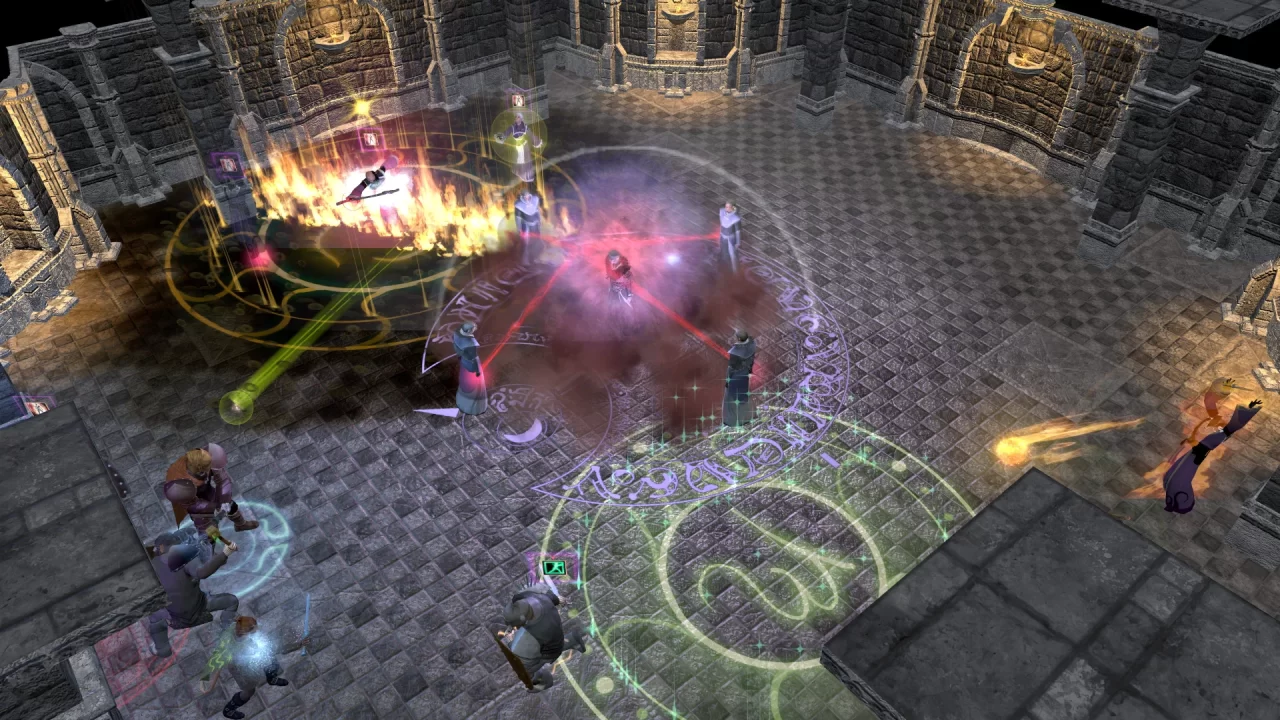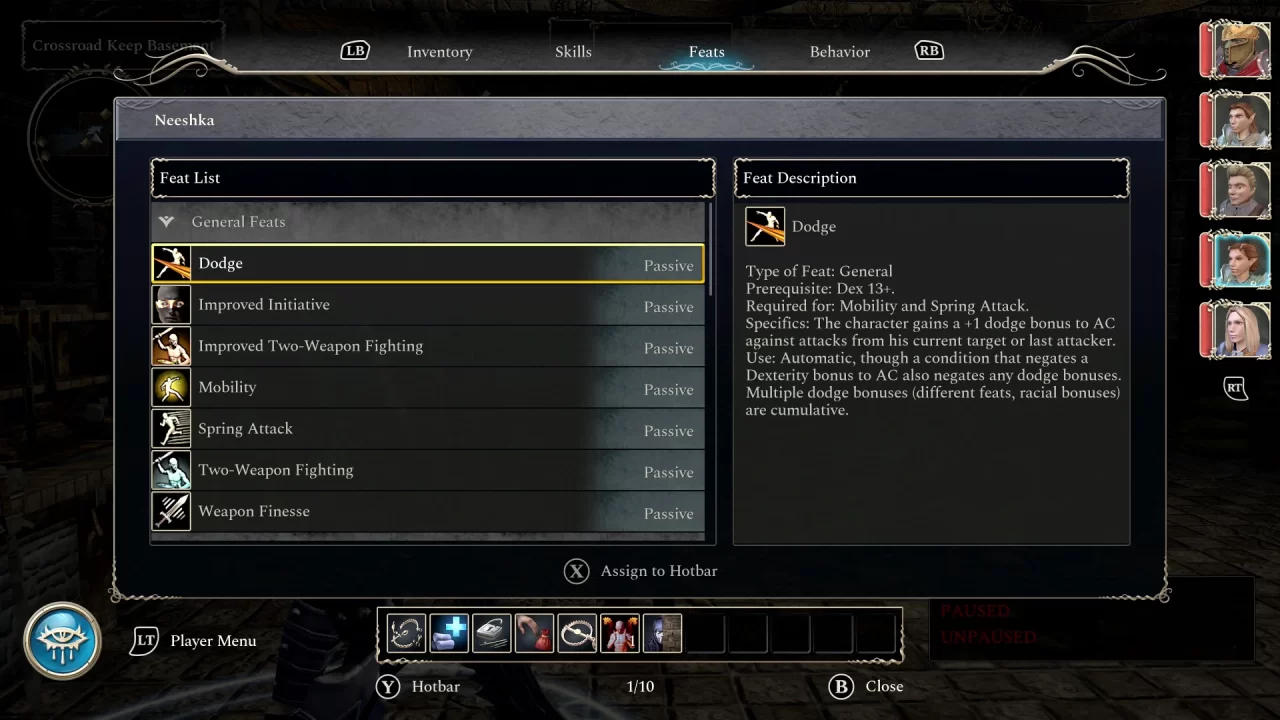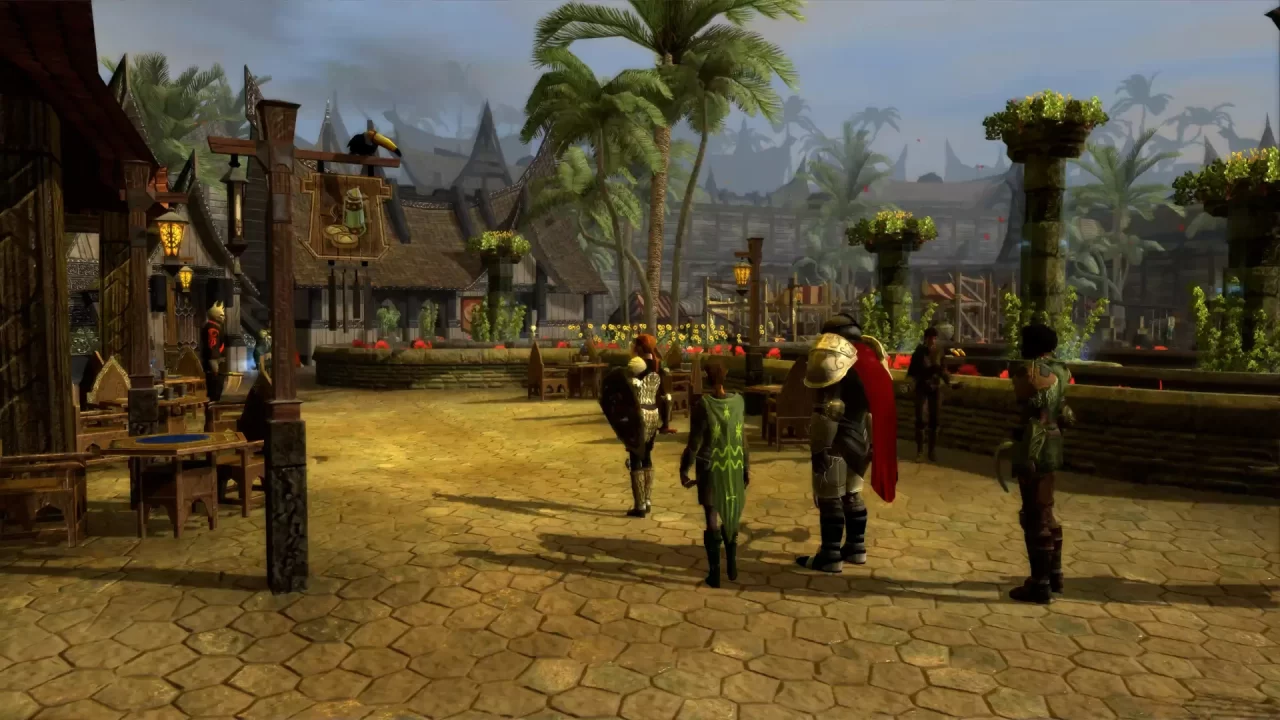I can’t believe we finally have a complete set of the remastered Neverwinter Nights series.
After the accomplished rework of the original CRPG game, Aspyr has brought the classic follow-up, Neverwinter Nights 2: Enhanced Edition—a game some believed unlikely to make the journey—to modern devices. But now with a heavy +1 shield in hand, an ancient evil to destroy, and a band of rudimentary AI companions in tow, Neverwinter Nights 2 strides purposefully into the hinterlands like an old soldier with a newly polished set of armor and plenty of tales to tell. Yes, players may face the rather archaic Dungeons and Dragons 3.5 Edition rules and some cliched creatures and story beats, but they’ll have a bloody good time out there regardless.
Aspyr haven’t skimped on the basic package with Neverwinter Nights 2: Enhanced Edition. Alongside the base game, all three of the premium expansions (Mask of the Betrayer, Storm of Zehir, and Mysteries of Westgate) are included and remastered. With all the modules, options are now updated to provide greater control over the visual fidelity of the upgraded graphics, and there’s support for modern resolutions across the board. There’s also cross-play support, Steam Deck compatibility, and the promise of Steam Workshop mods in the future. Everything boots and runs smoothly; loading times can seem a little long, though this is something that tweaks to optimization before launch may well fix.
After the reworked intro movie and splash screen, character creation for the selected adventure offers a large range of options that draw from the 3.5 Edition rules of the time. This means there’s a wide range of class options (expanded from the original game) as well as a huge number of feats, spells, and race ancestries. Players can freely build everything from basic fighters and clerics to more nuanced classes, like swashbucklers and favored souls. Theorycrafters will have a great time min-maxing the heck out of every possible multi-class option and feat combo, although the opaque class systems still pose a significant barrier to newcomers. The remaster offers no additional class build tutorial, so it’s entirely possible to build a cool character who is mechanically weak in combat or social situations. The default difficulty is pretty unforgiving, and considering there’s no way to respec your PC or your companions, it can feel punishing for players who aren’t familiar with the ruleset or with experience in similarly crunchy titles.
The original narrative remains untouched and, much like its predecessor, the story still doesn’t resonate too strongly. Players embody a young orphan from the small village of West Harbor who discovers a connection to a powerful artifact, the silver shard, and the looming threat of the King of Shadows. The path to understanding the shard and how it links to this ancient evil forms much of the heroic journey in and around the grand city of Neverwinter. There’s no sweeping social commentary here, but there’s something to be said about how the traditional story beats fit the system and the pastoral setting of the Faerun. It’s perhaps a reminder of where the genre was nearly twenty years ago. You’ll find plenty of incensed bandits, displaced refugees, and closed merchant roads as the story gets moving. Having said all that, the presence of githyanki in the narrative leads to some unexpected and satisfying connections to the most recent Forgotten Realms tale.
The vanilla game’s hackneyed moments notwithstanding, the writing and pacing remain effective, and the occasional voice-overs add verisimilitude even when some line deliveries are very flat. Heck, it’s a lot more traditional and internally consistent than some recent genre offers. In a manner akin to its earlier stablemate, Knights Of The Old Republic, Neverwinter Nights 2 does a much better job of writing and developing party companions, and it’s a pleasant surprise to remember the sequel allows more party companions than the lonely henchman system of the original. The morally reprehensible ranger, Bishop, provides a rich contrast to the do-goodness of the main plot. Others, like the wizard-spy Sand, are rooted in a deep sense of the world’s lore and history. Speaking of the audio, little else has changed. The sweeping orchestral soundtrack remains the same, and though it’s not one of the more memorable of the genre, it does fit the action seamlessly enough.
Once the familiar tutorial level of the core campaign spins up (the damned nostalgia of that village fair!), the camera options and reworked controls immediately stand out. Although it occasionally gets caught in ceiling rafters or shoved into a character’s cranium during large-scale combat, the camera generally behaves much better than previously. Graphics look sharp overall, with new textures, shadows, and luminosity bringing a noticeable boost. Foliage and water reflections show improvement, and the level of detail on smaller assets—chests, books, a cleaver embedded in a slab of meat—makes a real difference to the world’s vibrancy. Character clothing and facial details are equally crisp, aside from noticeable texture stretching. While performance is mostly stable, a few issues persist: occasional clipping, texture bugs, and rare instances where character models display grotesque distortions of their jaws and eyes. At times, upgraded textures give flat surfaces an oddly rounded or inflated appearance. New particle effects—like flaming weapons—add to the ambient detail. These enhancements don’t always carry over to the wider environment, as seen with the fireplaces and general flames still relying on basic animation loops. Overall, the remastered graphics succeed in enriching the world and revealing details that were either missing or obscured in the original. With time, it’s likely that some of the rougher visual glitches will be patched out as well.
Unlike the original Neverwinter Nights, Neverwinter Nights 2‘s zone areas feel smaller and more focused. While a few branching paths exist, they don’t offer the broader sense of discovery or exploration found in the first game or the even earlier spiritual predecessors. This is where the additional expansions shine more brightly. Their richer narrative nuance and the chances to travel through more varied locales—beyond simple druid groves and musty swamp caves—help elevate the experience. Given the party’s painfully slow movement speed, at least the zones don’t overstay their welcome. Still, the sluggish jog between locations to advance a quest chain is an unwelcome throwback to simpler times.
Gamepad control has been added, and it’s mostly a positive experience. Some of the menu nesting and triggers take some getting used to—I lost count of how many times I hit ‘Back’ trying to open my party menu—but I spent most of my time playing with the pad. Setting up the hotbar is easy enough, and the spell and ability sections work well as an extension of the d-pad. Don’t expect much beyond these conveniences, though: there’s no option to run, and targeting enemies or objects still sometimes means dancing around like a lunatic when your party crowds around you or when multiple loot drops are in play. The age of the systems also shows in the lack of tooltips or right-click functionality. Checking gear and moving it between companions remains as clumsy as ever, aside from some basic drag-and-drop features. Unfortunately, you can’t edit gamepad bindings, so you’ll need to manage any inefficiencies in the control throughout the game or rely on keyboard and mouse, which work almost identically to the original Neverwinter Nights 2.
When combat begins, the real-time-with-pauses system kicks in, and you’ll find yourself selecting abilities from the hotbar and manically clicking on enemies to attack. You can adjust companion behavior, and they’ll try to make smart decisions, albeit with an irritating compulsion to trigger as many fights as possible in a confined area, or provoke pointless attacks of opportunity by changing targets randomly. Besides damage numbers, there’s not a great deal of useful feedback in combat either, unless you follow the logbook assiduously. Much of this comes down to the older elements of the UI: it’s not immediately clear how to identify or cure effects that reduce ability scores or stats, and the conditions for sneak attacks remain a bit of a mystery. Ultimately, I found that setting combat to ‘puppet mode,’ where companions respond only to direct commands, offered the most tactical control, though battles ran significantly longer. The challenge and complexity of the creatures and critters evolve over the story, and this serves to keep the combat varied through the mid- to late-game. There’s no doubt Act 1 feels like a bit of a slog through countless thugs, orcs, and undead who don’t offer much strategic depth. Despite these frustrations, the sheer volume of available strategies and actions is staggering, and it’s genuinely rewarding to carefully prepare for a tough encounter and emerge victorious.

As well as the social and combat challenges, Neverwinter Nights 2 retains a detailed crafting system for both equipment and alchemy. You’ll need to scour zones for recipe books, base moulds, and source the right components. With the appropriate crafting skill, a character can then use a workbench to attempt creation. Aside from a few basic puzzles and companion quests, the game otherwise sticks closely to the core elements of the 3.5 ruleset. There’s some limited roleplaying, but given the limited resources of the time, these options mostly guide players to the same point in the story rather than allowing for major deviations. There is a simple influence system to keep tabs on, where companions view your actions against their own moral compass, but it doesn’t have much effect other than unlocked conversations and the chance they may cease to travel with you. Combat is the primary focus, and there’s plenty of it.
The bundled expansion and adventure packs add more variety to the core systems. In addition to continuing the main plot, Mask of the Betrayer retains the extra abilities and the ‘spirit-eating’ mechanic from earlier content. The challenge remains as punishing as ever, but the expansion provides a different perspective on both plot and gameplay. The overland map in Storms of Zehir and the enhanced party customization and collaboration also contribute variety, though the story feels a bit tepid. Finally, Mysteries of Westgate returns to urban-mystery storytelling, adding another dozen or so hours of content.
It’s fair to say the whole package offers solid value. Completing every expansion and experimenting with different builds, narrative branches, and companion combinations provides dozens upon dozens of hours of content. Add in cooperative multiplayer and Steam Workshop integration, and it’ll be fascinating to see how much traction Neverwinter Nights 2 gains this second time around given the continued success of the original (and its remaster) within the modding and player-creation community.
This is now the best way to experience Neverwinter Nights 2 in its entirety—whether you’re new to the game or returning after breaking your old copy with countless incompatible mods and error-strewn patches. Gamepad support and enhanced visuals and audio bring it much closer to modern expectations, while the lived-in world and even greater range of character options offer plenty to explore. The expansions, included here with the same level of polish, significantly enhance the package. Yes, there are archaic frustrations that cannot be ignored, but they have a less significant impact on the experience as a result of all the other improvements. Neverwinter Nights 2: Enhanced Edition rekindles a game that never quite reached the heights of its legendary bloodline. But now, with a degree of acceptance and patience, it can step onto the stage with all the confidence of an old soldier, sharing stories of how adventures used to be. Are you ready to listen?




